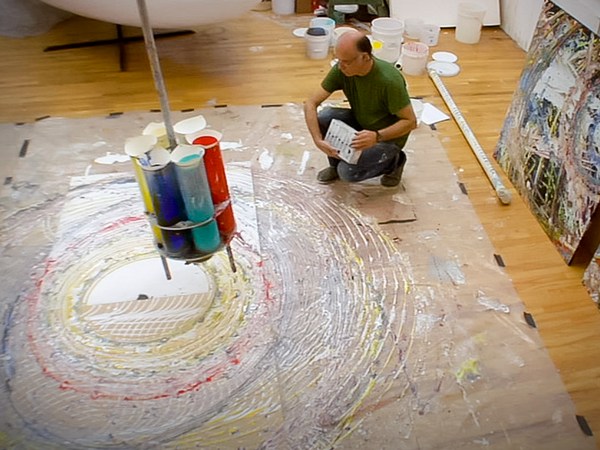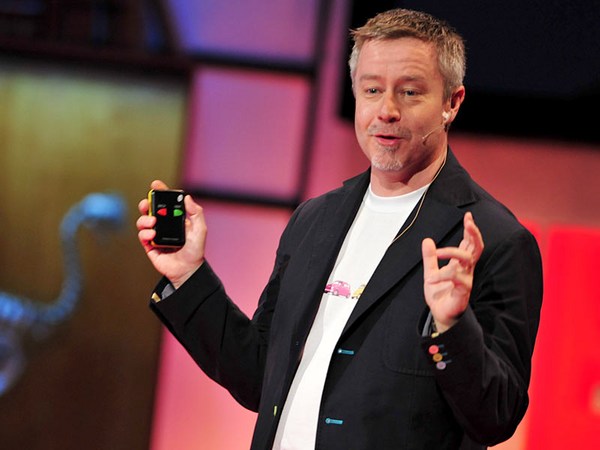I am no designer, nope, no way. My dad was, which is kind of an interesting way to grow up. I had to figure out what it is my dad did and why it was important.
Dad talked a lot about bad design when we were growing up, you know, "Bad design is just people not thinking, John," he would say whenever a kid would be injured by a rotary lawn mower or, say, a typewriter ribbon would get tangled or an eggbeater would get jammed in the kitchen.
You know, "Design -- bad design, there's just no excuse for it. It's letting stuff happen without thinking about it. Every object should be about something, John. It should imagine a user. It should cast that user in a story starring the user and the object.
Good design," my dad said, "is about supplying intent." That's what he said.
Dad helped design the control panels for the IBM 360 computer. That was a big deal; that was important. He worked for Kodak for a while; that was important. He designed chairs and desks and other office equipment for Steelcase; that was important. I knew design was important in my house because, for heaven's sake, it put food on our table, right?
And design was in everything my dad did. He had a Dixieland jazz band when we were growing up, and he would always cover Louis Armstrong tunes. And I would ask him every once in a while,
"Dad, do you want it to sound like the record?" We had lots of old jazz records lying around the house. And he said, "No, never, John, never. The song is just a given, that's how you have to think about it. You gotta make it your own. You gotta design it. Show everyone what you intend," is what he said. "Doing that, acting by design, is what we all should be doing. It's where we all belong."
All of us? Designers? Oh, oh, Dad. Oh, Dad.
The song is just a given. It's how you cover it that matters. Well, let's hold on to that thought for just a minute. It's kind of like this wheelchair I'm in, right? The original tune? It's a little scary.
"Ooh, what happened to that dude? He can't walk. Anybody know the story? Anybody?"
I don't like to talk about this very much, but I'll tell you guys the story today. All right, exactly 36 years ago this week, that's right, I was in a poorly designed automobile that hit a poorly designed guardrail on a poorly designed road in Pennsylvania, and plummeted down a 200-foot embankment and killed two people in the car. But ever since then, the wheelchair has been a given in my life. My life, at the mercy of good design and bad design.
Think about it. Now, in design terms, a wheelchair is a very difficult object. It mostly projects tragedy and fear and misfortune, and it projects that message, that story, so strongly that it almost blots out anything else.
I roll swiftly through an airport, right? And moms grab their kids out of the way and say, "Don't stare!" The poor kid, you know, has this terrified look on his face, God knows what they think. And for decades, I'm going, why does this happen? What can I do about it? How can I change this? I mean there must be something. So I would roll, I'd make no eye contact -- just kinda frown, right? Or I'd dress up really, really sharply or something. Or I'd make eye contact with everyone -- that was really creepy; that didn't work at all. (Laughter) You know anything, I'd try. I wouldn't shower for a week -- nothing worked.
Nothing whatsoever worked until a few years ago, my six-year-old daughters were looking at this wheelchair catalog that I had, and they said,
"Oh, Dad! Dad! Look, you gotta get these, these flashy wheels -- you gotta get 'em!"
And I said, "Oh, girls, Dad is a very important journalist, that just wouldn't do at all."
And of course, they immediately concluded,
"Oh, what a bummer, Dad. Journalists aren't allowed to have flashy wheels. I mean, how important could you be then?" they said.
I went, "Wait a minute, all right, right -- I'll get the wheels." Purely out of protest,
I got the flashy wheels, and I installed them and -- check this out. Could I have my special light cue please? (Laughter) Look at that! Now ... look at, look at this! Look at this!
So what you are looking at here has completely changed my life, I mean totally changed my life. Instead of blank stares and awkwardness, now it is pointing and smiling!
People going, "Awesome wheels, dude! Those are awesome! I mean, I want some of those wheels!" Little kids say, "Can I have a ride?" (Laughter)
And of course there's the occasional person -- usually a middle-aged male who will say, "Oh, those wheels are great! I guess they're for safety, right?" (Laughter) No! They're not for safety. No, no, no, no, no.
What's the difference here, the wheelchair with no lights and the wheelchair with lights? The difference is intent. That's right, that's right; I'm no longer a victim. I chose to change the situation -- I'm the Commander of the Starship Wheelchair with the phaser wheels in the front. Right? Intent changes the picture completely. I choose to enhance this rolling experience with a simple design element. Acting with intent. It conveys authorship. It suggests that someone is driving. It's reassuring; people are drawn to it. Someone making the experience their own. Covering the tragic tune with something different, something radically different. People respond to that.
Now it seems simple, but actually I think in our society and culture in general, we have a huge problem with intent. Now go with me here. Look at this guy. You know who this is? It's Anders Breivik. Now, if he intended to kill in Olso, Norway last year, dozens and dozens of young people -- if he intended to do that, he's a vicious criminal. We punish him. Life in prison. Death penalty in the United States, not so much in Norway. But, if he instead acted out of a delusional fantasy, if he was motivated by some random mental illness, he's in a completely different category. We may put him away for life, but we watch him clinically. It's a completely different domain. As an intentional murderer, Anders Breivik is merely evil. But as a dysfunctional, as a dysfunctional murderer/psychotic, he's something much more complicated. He's the breath of some primitive, ancient chaos. He's the random state of nature we emerged from. He's something very, very different.
It's as though intent is an essential component for humanity. It's what we're supposed to do somehow. We're supposed to act with intent. We're supposed to do things by design. Intent is a marker for civilization.
Now here's an example a little closer to home: My family is all about intent. You can probably tell there are two sets of twins, the result of IVF technology, in vitro fertilization technology, due to some physical limitations I won't go into. Anyway, in vitro technology, IVF, is about as intentional as agriculture. Let me tell you, some of you may have the experience. In fact, the whole technology of sperm extraction for spinal cord-injured males was invented by a veterinarian. I met the dude. He's a great guy. He carried this big leather bag full of sperm probes for all of the animals that he'd worked with, all the different animals. Probes he designed, and in fact, he was really, really proud of these probes.
He would say, "You're right between horse and squirrel, John." (Laughter) But anyway, so when my wife and I decided to upgrade our early middle age -- we had four kids, after all -- with a little different technology that I won't explain in too much detail here -- my urologist assured me I had nothing whatsoever to worry about.
"No need for birth control, Doc, are you sure about that?"
"John, John, I looked at your chart. From your sperm tests we can confidently say that you're basically a form of birth control."
Well! (Laughter) What a liberating thought! Yes! And after a couple very liberating weekends, my wife and I, utilizing some cutting-edge erectile technology that is certainly worthy of a TEDTalk someday but I won't get into it now, we noticed some familiar, if unexpected, symptoms. I wasn't exactly a form of birth control. Look at that font there. My wife was so pissed.
I mean, did a designer come up with that? No, I don't think a designer did come up with that. In fact, maybe that's the problem. And so, little Ajax was born. He's like our other children, but the experience is completely different. It's something like my accident, right? He came out of nowhere. But we all had to change, but not just react to the given; we bend to this new experience with intent. We're five now. Five. Facing the given with intent. Doing things by design. Hey, the name Ajax -- you can't get much more intentional than that, right? We're really hoping he thanks us for that later on. (Laughter)
But I never became a designer. No, no, no, no. Never attempted. Never even close. I did love some great designs as I was growing up: The HP 35S calculator -- God, I loved that thing. Oh God, I wish I had one. Man, I love that thing. I could afford that. Other designs I really couldn't afford, like the 1974 911 Targa. In school, I studied nothing close to design or engineering; I studied useless things like the Classics, but there were some lessons even there -- this guy, Plato, it turns out he's a designer. He designed a state in "The Republic," a design never implemented. Listen to one of the design features of Plato's Government 4.0:
"The State in which the rulers are most reluctant to govern is always the best and most quietly governed, and the State in which they are most eager, the worst."
Well, got that wrong, didn't we? But look at that statement; it's all about intent. That's what I love about it. But consider what Plato is doing here. What is he doing? It's a grand idea of design -- a huge idea of design, common to all of the voices of religion and philosophy that emerged in the Classical period. What was going on then? They were trying to answer the question of what would human beings do now that they were no longer simply trying to survive? As the human race emerged from a prehistoric chaos, a confrontation with random, brutal nature, they suddenly had a moment to think -- and there was a lot to think about. All of a sudden, human existence needed an intent. Human life needed a reason. Reality itself needed a designer. The given was replaced by various aspects of intent, by various designs, by various gods. Gods we're still fighting about. Oh yeah.
Today we don't confront the chaos of nature. Today it is the chaos of humanity's impact on the Earth itself that we confront. This young discipline called design, I think, is in fact the emerging ethos formulating and then answering a very new question: What shall we do now in the face of the chaos that we have created? What shall we do? How shall we inscribe intent on all the objects we create, on all the circumstances we create, on all the places we change? The consequences of a planet with 7 billion people and counting. That's the tune we're all covering today, all of us. And we can't just imitate the past. No. That won't do. That won't do at all.
Here's my favorite design moment: In the city of Kinshasa in Zaire in the 1990s, I was working for ABC News, and I was reporting on the fall of Mobutu Sese Seko, the dictator, the brutal dictator in Zaire, who raped and pillaged that country. There was rioting in the middle of Kinshasa. The place was falling apart; it was a horrible, horrible place, and I needed to go and explore the center of Kinshasa to report on the rioting and the looting. People were carrying off vehicles, carrying off pieces of buildings. Soldiers were in the streets shooting at looters and herding some in mass arrests. In the middle of this chaos, I'm rolling around in a wheelchair, and I was completely invisible. Completely. I was in a wheelchair; I didn't look like a looter. I was in a wheelchair; I didn't look like a journalist, particularly, at least from their perspective. And I didn't look like a soldier, that's for sure. I was part of this sort of background noise of the misery of Zaire, completely invisible. And all of a sudden, from around a corner, comes this young man, paralyzed, just like me, in this metal and wood and leather pedal, three-wheel tricycle-wheelchair device, and he pedals up to me as fast as he can.
He goes, "Hey, mister! Mister!"
And I looked at him -- he didn't know any other English than that, but we didn't need English, no, no, no, no, no. We sat there and compared wheels and tires and spokes and tubes. And I looked at his whacky pedal mechanism; he was full of pride over his design. I wish I could show you that contraption. His smile, our glow as we talked a universal language of design, invisible to the chaos around us. His machine: homemade, bolted, rusty, comical. My machine: American-made, confident, sleek. He was particularly proud of the comfortable seat, really comfortable seat he had made in his chariot and its beautiful fabric fringe around the edge. Oh, I wish I'd had those sparkly wheels back then to have shown him, man! He would have loved those! Oh yeah. He would have understood those; a chariot of pure intent -- think about it -- in a city out of control. Design blew it all away for a moment. We spoke for a few minutes and then each of us vanished back into the chaos. He went back to the streets of Kinshasa; I went to my hotel. And I think of him now, now ...
And I pose this question. An object imbued with intent -- it has power, it's treasure, we're drawn to it. An object devoid of intent -- it's random, it's imitative, it repels us. It's like a piece of junk mail to be thrown away. This is what we must demand of our lives, of our objects, of our things, of our circumstances: living with intent. And I have to say that on that score, I have a very unfair advantage over all of you.
And I want to explain it to you now because this is a very special day. Thirty-six years ago at nearly this moment, a 19-year-old boy awoke from a coma to ask a nurse a question, but the nurse was already there with an answer.
"You've had a terrible accident, young man. You've broken your back. You'll never walk again."
I said, "I know all that -- what day is it?" You see, I knew that the car had gone over the guardrail on the 28th of February, and I knew that 1976 was a leap year.
"Nurse! Is this the 28th or the 29th?"
And she looked at me and said, "It's March 1st."
And I went, "Oh my God. I've got some catching up to do!" And from that moment, I knew the given was that accident; I had no option but to make up this new life without walking. Intent -- a life with intent -- lived by design, covering the original with something better. It's something for all of us to do or find a way to do in these times.
To get back to this, to get back to design, and as my daddy suggested a long time ago,
"Make the song your own, John. Show everybody what you intend."
Daddy, this one's for you. (Music)
♫ Jo Jo was a man who thought he was a loner ♫ ♫ but he was another man. ♫ ♫ Jo Jo left his home in Tucson, Arizona to attend a California bash. ♫ ♫ Get back, get back, ♫ ♫ get back to where you once belonged. ♫ ♫ Get back, get back, ♫ ♫ get back to where you once belonged. ♫ (Applause)





